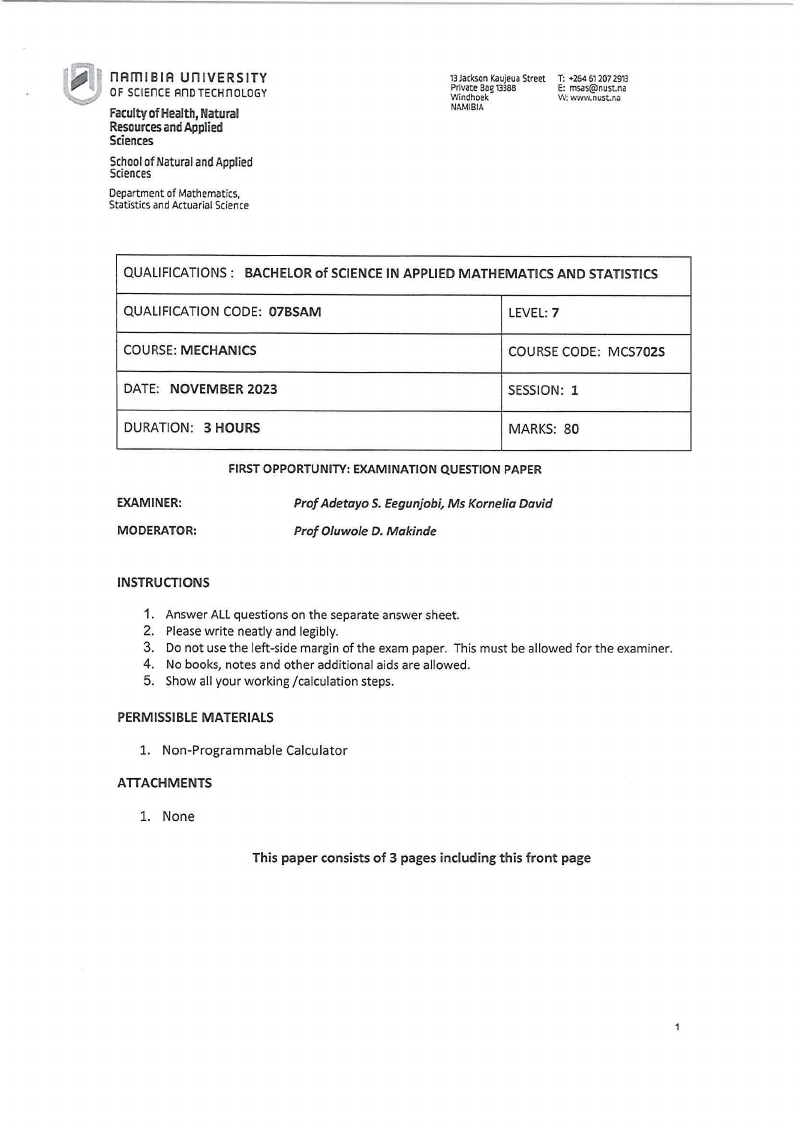 |
MCS702S - MECHANICS - 1ST OPP - NOVEMBER 2023 |
 |
1 Page 1 |
▲back to top |

nAm I BIA UnlVERS ITV
OF science Ano TECHno LOGY
FacultyofHealthN, atural
ResourceasndApplied
Sciences
Schoool f NaturalandApplied
Sciences
Departmentof Mathematics,
StatisticsandActuarialScience
13JacksonKaujeuaStreet
PrivateBag13388
Windhoek
NAMIBIA
T: •264 61207 2913
E: msas@nust.na
W: www.nust.na
QUALIFICATIONS: BACHELOR of SCIENCE IN APPLIED MATHEMATICS AND STATISTICS
QUALIFICATIONCODE: 07BSAM
COURSE:MECHANICS
DATE: NOVEMBER 2023
DURATION: 3 HOURS
LEVEL:7
COURSECODE: MCS702S
SESSION: 1
MARKS: 80
FIRST OPPORTUNITY: EXAMINATION QUESTION PAPER
EXAMINER:
MODERATOR:
Prof Adetayo S. Eegunjobi, Ms Kornelia David
Prof Oluwole D. Makinde
INSTRUCTIONS
1. Answer ALL questions on the separate answer sheet.
2. Pleasewrite neatly and legibly.
3. Do not use the left-side margin of the exam paper. This must be allowed for the examiner.
4. No books, notes and other additional aids are allowed.
5. Show all your working /calculation steps.
PERMISSIBLE MATERIALS
1. Non-Programmable Calculator
ATTACHMENTS
1. None
This paper consists of 3 pages including this front page
 |
2 Page 2 |
▲back to top |

MCS702S
Mechanics
l. (a) The position of a squirrel running through the park is given as
November 2023
i. What are vx(t) and vy(t), the x- and y-components of the velocity of the squirrel,
as functions of time?
(3)
11. At t = 6s, how far is the squirrel from its initial position?
(3)
111. At t = 6s, what are the magnitude and direction of the squirrel's velocity?~
r;)
(b) Newton sets out from his home to deliver flyers for his yard sale, traveling due east
along his street lined with houses. At 0.5 km and 9 minutes later he runs out of
flyers and has to retrace his steps back to his house to get more. This takes an
additional 9 minutes. After picking up more flyers, he sets out again on the same
path, continuing where he left off, and ends up 1.0 km from his house. This third
leg of his trip takes 15 minutes. At this point he turns back toward his house,
heading west. After 1.75 km and 25 minutes he stops to rest.
1. What is Newtons total displacement to the point where he stops to rest?
(3)
11. What is the total distance traveled?
(3)
2. (a) An animal moves steadily in a linear path, where we define the x-a..'<iswith the
rightward direction as positive in meter. The animal's position as a function of
time is described by the equation:
x(t) = 50 + 2t - 0.0625t2.
i. Determine the animal's starting velocity, initial position and its initial accele-
ration.
(3)
ii. When does the animal's velocity reach zero?
(3)
m. After how much time from the beginning does the animal come back to its
initial position?
(3)
iv. During which time intervals tis the animal situated at a distance of 10m from
its initial point, and what are the magnitudes and directions of the turtle's
velocities at these moments?
(3)
(b) If a beetle is capable of vertically jumping to a maximum height of 0.440 m,
i. What is its initial speed as it leaves the ground?
(3)
ii. How long is it in the air?
(3)
3. (a) Two football players, one weighing 95 kg and moving at 3.75 m/s, and the other wei-
ghing 111 kg and moving at 4.10 m/s, approach each other along a linear trajectory.
They eventually collide head-on and become entangled.
i. What is their velocity immediately after the collision?
(5)
ii. What are the initial and final kinetic energies of the system?
(5)
(b) Two cars have a collision at a perpendicular intersection. In a top-down view of this
intersection, the first car, weighing 950 kg, is approaching from the left at a speed
of 16 m/s. The second car, with a mass of 1300 kg, is approaching from below at
a speed of 21 m/s. After the collision, they merge together. Find the speed and
direction of the vehicles just after the collision. Assume there are no external forces (7)
 |
3 Page 3 |
▲back to top |

MCS702S
Mechanics
November 2023
4. (a) A force parallel to the x-a.--<iascts on a particle moving along the x-axis. This
force produces potential energy P(x) given P(x) = l.43x 4J/m 2 . What is the force
(magnitude anddirection) when the particle is at x = -0.780m?
(5)
(b) A small block with mass 0.04 kg is moving in the >.-y-plane. The net force on the
block is described by the potential energy function
P(x, y) = (3.85J/m 2)x2 - (3.65J/m 3)y3 .
What are the magnitude and direction of the acceleration of the block when it is
atthe point x = 0.28m, y = 0.57m?
(10)
5. (a) Suppose homas hit a ball 35m/s at an angle of 60° above the horizontal.
i. Determine the maximum height reached by the ball
(3)
ii. How long does thee ball stay in the air
(3)
iii. Determine the horizontal distance covered by the ball
(3)
(b) A soccer ball is kicked from the ground with an initial speed of 12.5m/s at an
upward angke of 55°. A player 40m away in the direction of the kick starts running
back to meet the ball at that instant. What must be the average speed, if he is to
meet the ball just before it hit the ground?
(6)
End of Exam!
3





